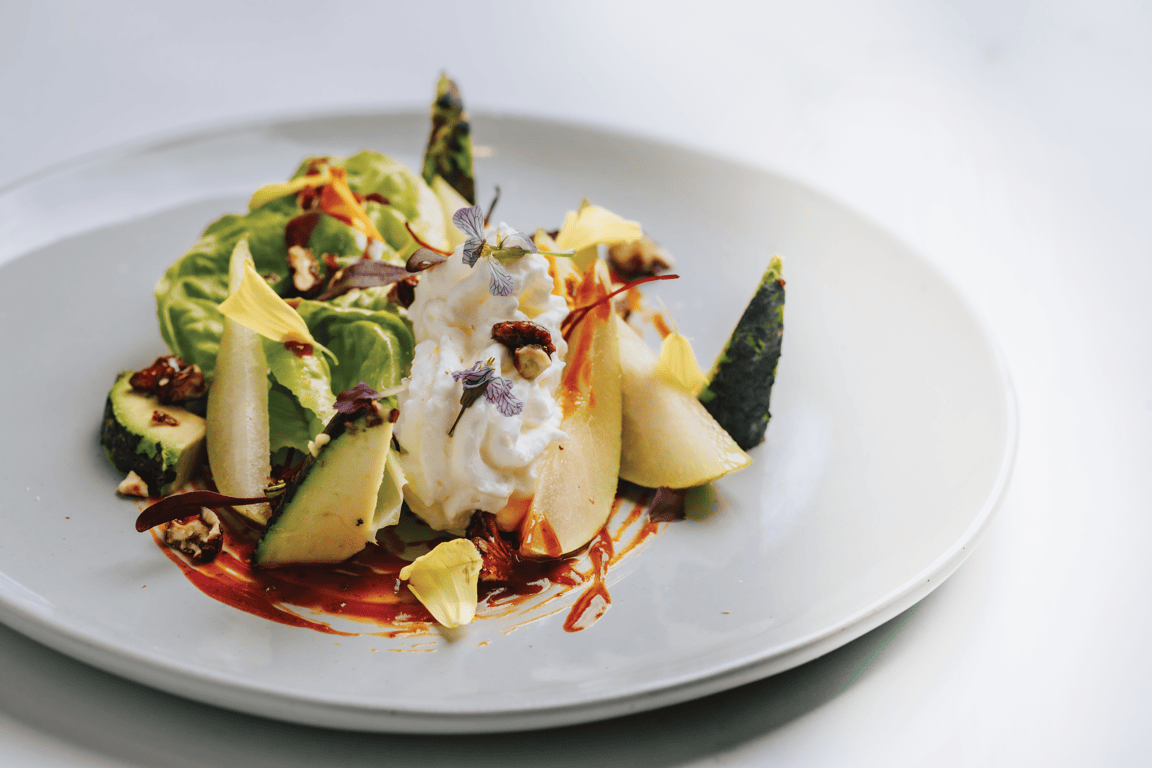
Modern Dressings Move In
Creative iterations energize the salad category
Modern Dressings Move In
Creative iterations energize the salad category
By Katie Ayoub
February 7, 2024
By Katie Ayoub
February 7, 2024
Salads are back in the game after ceding the court to bowls for more than a decade. They’ve certainly learned from modern bowl builds, borrowing inspiration by employing next-level textural counterpoint and nuanced flavor-building techniques. And while careful attention is being paid to all salad components, it’s the dressing that’s now coming into sharp focus for innovation.
Small but mighty moves mark the trend in salad dressings. Chefs are celebrating unexpected flavor combinations, creative vegan twists, global flavor touches and reimagined classics, and they are cleverly applying textural elements like swipes, swooshes and finishing flourishes. Leading-edge concepts showcase the possibilities. At Paper Rice in Pasadena, Calif., the Sautéed Salad features romaine hearts topped with shrimp, beef, hard-boiled eggs and sweet onion, with a Vietnamese-inspired dressing enriched with beef and shrimp drippings. Wood, a New American restaurant in Chicago, demonstrates a layered approach with its Winter Salad, delivering a dynamic eating experience and avoiding flavor fatigue. A clever contrast of spiced palm date purée and honey-sherry vinaigrette adds a complex mouthfeel and flavor to the blend of baby red oak and chicory lettuces, persimmon, roasted delicata squash, pomegranate, pain d’epices, hazelnut and manchego.
“As menu innovators, we often let salads fall to the side,” says Mindy Armstrong, VP of menu innovation at Ascent Hospitality Management. “We focus on the big hits: the shareables, the bar bites, the bowls and the beverages. We devote less space on the menu for salads, so therefore we focus less on their development. We then try to manage that category, asking, ‘How do we get the right mix of salads that give us the most reach?’ Instead, we should be thinking, ‘How do we turn salads into a destination-worthy meal?’”
There’s an imperative to taking a studied approach. Making salads sing goes deeper than killing the veto vote or providing a perfunctory menu option. A number of drivers lead the charge for innovation, including the demand for wholesome, functional foods. “Salads aren’t just for one person at the table. So often today, everyone is a salad person,” says Claire Conaghan, trendologist and associate director of publications, Datassential. “Diners are ordering them to share, or as side options they can build on. The purchasing behavior isn’t even necessarily about health today, as much as it is about nutrition. For consumers, it’s an enjoyable way to up your plant intake, eat your veggies. For operators, it’s important to be competitive and give customers what they’re looking for.”
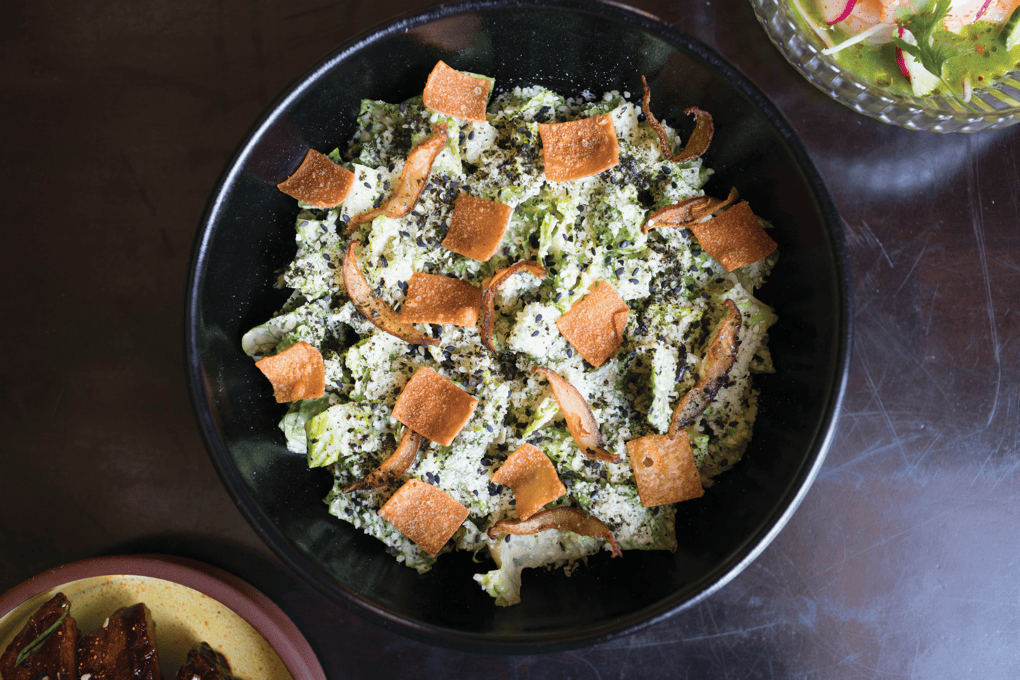 Photo Credit: Immigrant Food
Photo Credit: Immigrant Food Washington, D.C.-based gastro-advocacy restaurant group Immigrant Food presents an umami-packed Miso Caesar Salad with shiitake “bacon,” zesty wonton chips, nori and sesame seeds.
Indeed, the plant-forward movement gives particular lift to the salad category, creating a singular opportunity for innovation and distinction. “Salads are a great way to build ‘real food’ credibility,” says Dan Coudreaut, chef/owner of Lantern Pizza Co. and former executive chef and VP of culinary innovation at McDonald’s. “When we talk about plant-based trends, diners are looking more toward whole foods for their vegan/vegetarian lifestyle choices, rather than some of the meat analogues that were so popular for a while.” This tees up the importance of menuing modern, craveable salads. “You’ve got to make your salad options as great and as unique as possible,” he says. “Creative, flavorful dressings are key here.”
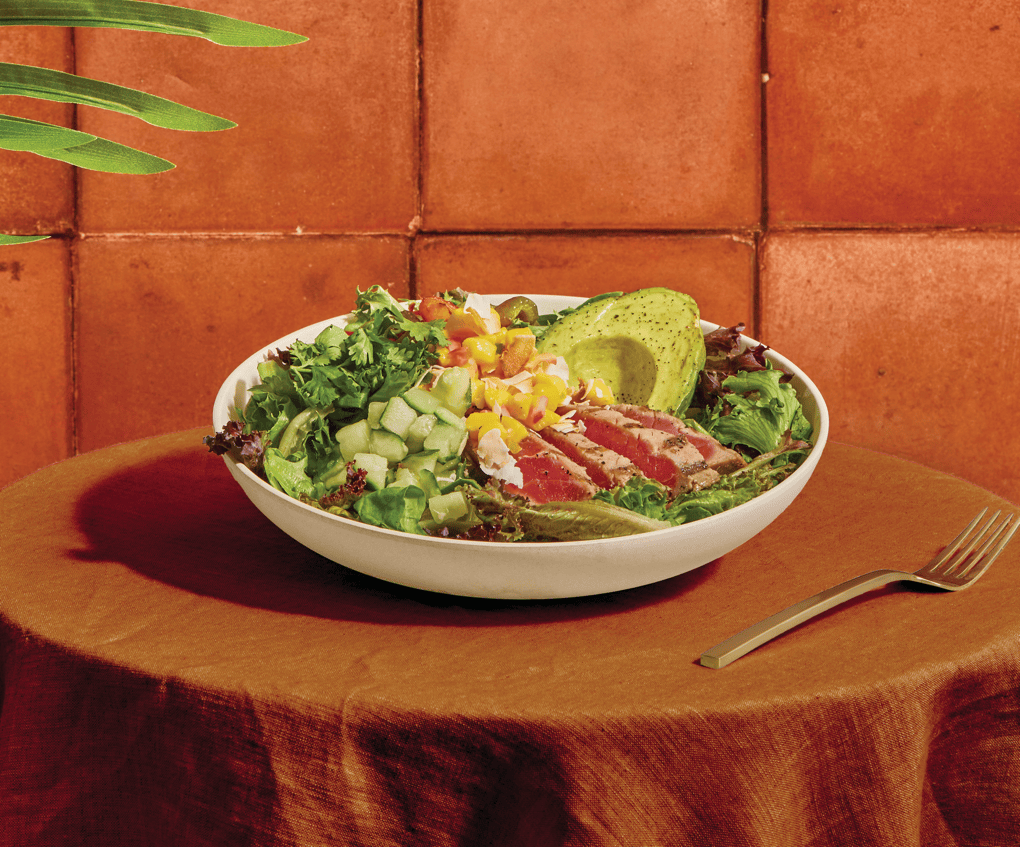 Photo Credit: Modern Market Eatery
Photo Credit: Modern Market Eatery For Modern Market Eatery’s Jerk Tuna Salad, a creamy jerk dressing directed the rest of the build: mixed greens, ahi tuna, roasted bell pepper, cucumber, mango salsa, toasted coconut, cilantro and avocado.
A Modern Approach
As VP of culinary for fast casual Modern Market Eatery, Nate Weir often has salad development in his crosshairs. For one recent menu addition, he took a different tack to land on the next hit. “I worked backward, making the dressing the hero ingredient,” he says. “So often when designing a salad, you start with the components and then work toward a dressing that makes sense with those flavors. This time, we flipped the script and started ideating on the dressing first, knowing we wanted something bold and spicy; then we built out the components of the salad that would surround that dressing.”
The result is Modern Market’s Jerk Tuna Salad, featuring mixed greens, line-caught ahi tuna, in-house roasted bell pepper, cucumber, mango salsa, toasted coconut, cilantro, avocado and a creamy jerk dressing. “We use authentic ingredients in the dressing: tons of shallot and onion, habanero, Scotch bonnet, brown sugar and beautiful warm Caribbean spices,” says Weir. “We cut the heat with Greek yogurt, so now we’ve got this wonderful tangy, spicy, creamy dressing. It’s fairly unexpected to find heat in a dressing for a leafy green salad, and this one gives us a really interesting profile that we can use year-round, featured on our core menu.”
Coudreaut emphasizes how a creative approach to salad dressings can help differentiate menus. “There are so many different levers to pull on a salad; dressing innovation is perhaps the most impactful,” he says. Last summer, he featured a Spinach Salad with goat cheese and strawberries. To lend it unique appeal, he created a chocolate-balsamic vinaigrette, blending olive oil and balsamic vinegar with melted semi-sweet chocolate. “Customers who ordered it were blown away. They loved it and came back for it,” says Coudreaut. “They remembered us for it.”
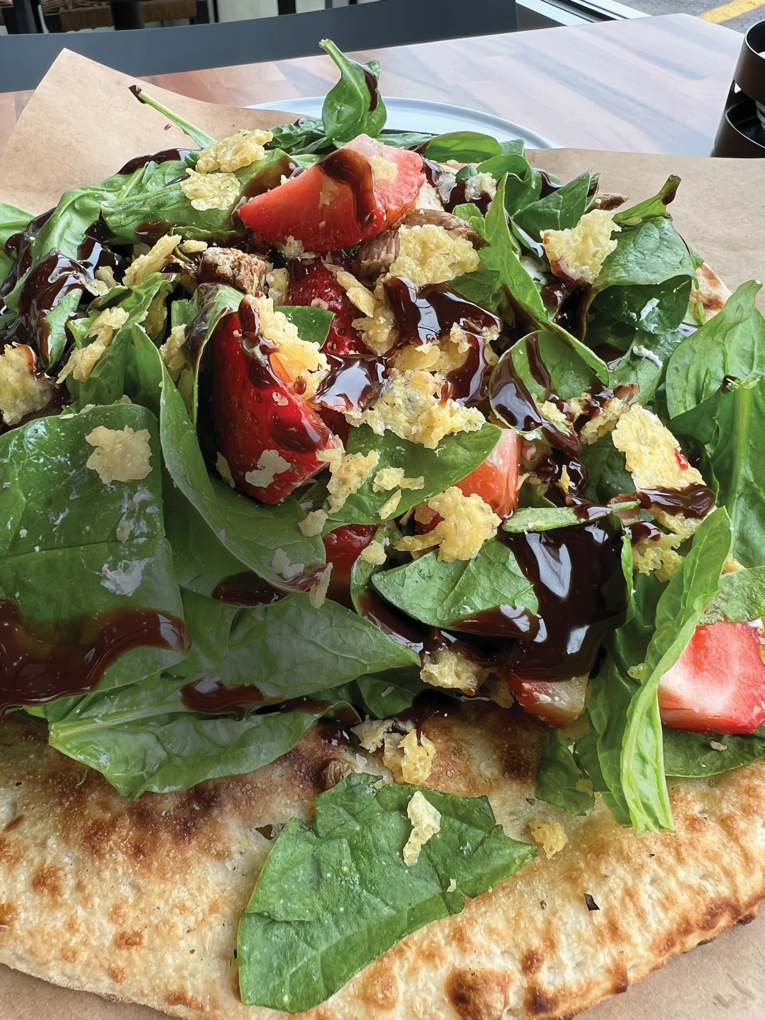 Photo Credit: Lantern Pizza Co.
Photo Credit: Lantern Pizza Co. The chocolate-balsamic vinaigrette steals the show in the Spinach Salad, with strawberries, crisp Parmesan and goat cheese, menued at Lantern Pizza Co. in Downers Grove, Ill.
Layering Effect
Introducing varying textures through layering dressings, finishing oils or sauces is a big part of this trend. “Salads are seeing a lighter hand with dressings, along with secondary drizzles or perhaps a base underneath a swipe or dollop,” says Conaghan. “It could be a seasoned labneh or tahini on the base and a drizzle of labneh over top.”
A close look at a few examples serves as a guide here. At Better Half Coffee & Cocktails in Austin, Texas, the Big Fall Salad, with romaine, baby kale, honey-roasted spaghetti squash, candied walnuts, pomegranate, chèvre and shaved baby turnip, adds textural interest with the addition of both a miso-butternut squash purée and a creamy tofu-cherry-miso dressing. Toro Toro, a Pan-Latin steakhouse in Miami, menus a Charred Avocado Pear Salad with Greek yogurt foam, candied walnuts and honey-chipotle vinaigrette, while Scandinavian café Destroyer in Los Angeles offers a Honey-Roasted Mushroom Salad with baby romaine, yuzu vinaigrette, sunflower seeds, barbecue sweet onions, sesame yogurt and puffed wild rice.
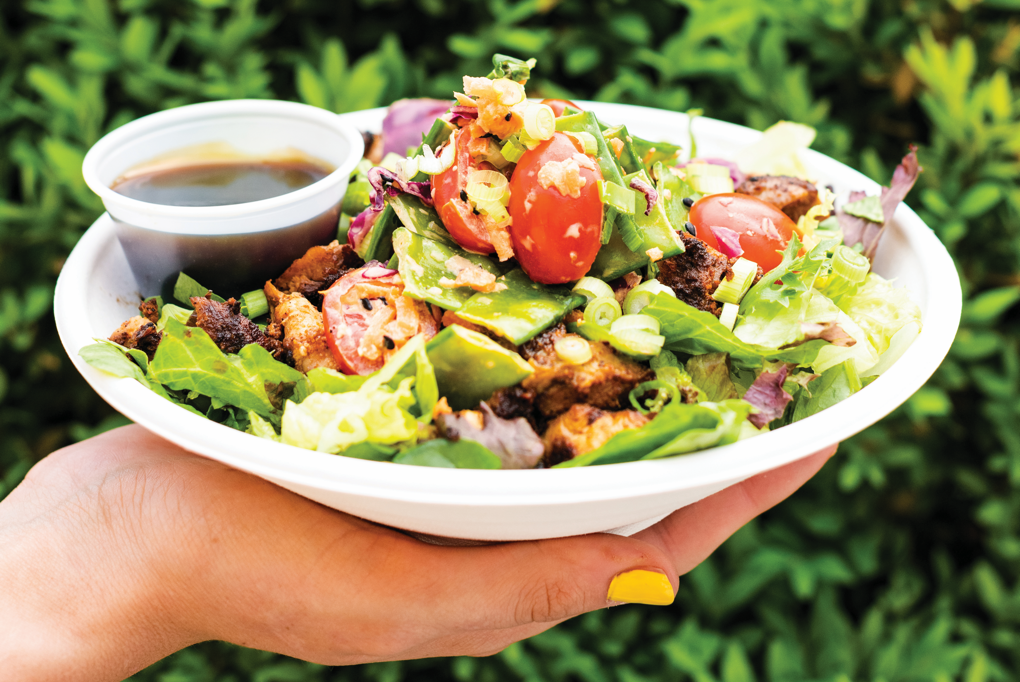 Photo Credit: Gusto!
Photo Credit: Gusto! Atlanta-based Gusto! employs a modern approach to its salad and bowl builds, pairing a complementary sauce with a dressing. Its Sweet Soy Sriracha salad, featuring a medley of snow peas, red bell pepper, purple cabbage and carrots, boasts both a sweet Japanese soy sauce and Sriracha-ginger dressing.
Gabe Erales is chef/partner of Yucatán-inspired Bacalar in Austin, Texas. His Charred Kale and Little Gem Lettuce stars masa miso, pan árabe crumbs, burnt onion vinaigrette and Cotija. “It eats like a dark malty Caesar dressing, with charred yellow onion, garlic, habanero, black sesame paste, sour orange, preserved lemon and fermented honey,” he says. The masa miso, fermented with rice koji, lends a corny sweetness to the salad. “You get a lot of umami with layers of sweetness. It’s delicious,” says Erales.
Creative pathways in dressing development are endless, granting differentiation with each successful iteration. “Why not push flavor boundaries here? Why can’t a salad dressing be spicy or fermented and funky, or made with green tea or taken in a completely new direction?” poses Weir. “There are so many possibilities—it’s exciting.”
Salads are back in the game after ceding the court to bowls for more than a decade. They’ve certainly learned from modern bowl builds, borrowing inspiration by employing next-level textural counterpoint and nuanced flavor-building techniques. And while careful attention is being paid to all salad components, it’s the dressing that’s now coming into sharp focus for innovation.
Small but mighty moves mark the trend in salad dressings. Chefs are celebrating unexpected flavor combinations, creative vegan twists, global flavor touches and reimagined classics, and they are cleverly applying textural elements like swipes, swooshes and finishing flourishes. Leading-edge concepts showcase the possibilities. At Paper Rice in Pasadena, Calif., the Sautéed Salad features romaine hearts topped with shrimp, beef, hard-boiled eggs and sweet onion, with a Vietnamese-inspired dressing enriched with beef and shrimp drippings. Wood, a New American restaurant in Chicago, demonstrates a layered approach with its Winter Salad, delivering a dynamic eating experience and avoiding flavor fatigue. A clever contrast of spiced palm date purée and honey-sherry vinaigrette adds a complex mouthfeel and flavor to the blend of baby red oak and chicory lettuces, persimmon, roasted delicata squash, pomegranate, pain d’epices, hazelnut and manchego.
“As menu innovators, we often let salads fall to the side,” says Mindy Armstrong, VP of menu innovation at Ascent Hospitality Management. “We focus on the big hits: the shareables, the bar bites, the bowls and the beverages. We devote less space on the menu for salads, so therefore we focus less on their development. We then try to manage that category, asking, ‘How do we get the right mix of salads that give us the most reach?’ Instead, we should be thinking, ‘How do we turn salads into a destination-worthy meal?’”
There’s an imperative to taking a studied approach. Making salads sing goes deeper than killing the veto vote or providing a perfunctory menu option. A number of drivers lead the charge for innovation, including the demand for wholesome, functional foods. “Salads aren’t just for one person at the table. So often today, everyone is a salad person,” says Claire Conaghan, trendologist and associate director of publications, Datassential. “Diners are ordering them to share, or as side options they can build on. The purchasing behavior isn’t even necessarily about health today, as much as it is about nutrition. For consumers, it’s an enjoyable way to up your plant intake, eat your veggies. For operators, it’s important to be competitive and give customers what they’re looking for.”
 Photo Credit: Immigrant Food
Photo Credit: Immigrant Food Washington, D.C.-based gastro-advocacy restaurant group Immigrant Food presents an umami-packed Miso Caesar Salad with shiitake “bacon,” zesty wonton chips, nori and sesame seeds.
Indeed, the plant-forward movement gives particular lift to the salad category, creating a singular opportunity for innovation and distinction. “Salads are a great way to build ‘real food’ credibility,” says Dan Coudreaut, chef/owner of Lantern Pizza Co. and former executive chef and VP of culinary innovation at McDonald’s. “When we talk about plant-based trends, diners are looking more toward whole foods for their vegan/vegetarian lifestyle choices, rather than some of the meat analogues that were so popular for a while.” This tees up the importance of menuing modern, craveable salads. “You’ve got to make your salad options as great and as unique as possible,” he says. “Creative, flavorful dressings are key here.”
 Photo Credit: Modern Market Eatery
Photo Credit: Modern Market Eatery For Modern Market Eatery’s Jerk Tuna Salad, a creamy jerk dressing directed the rest of the build: mixed greens, ahi tuna, roasted bell pepper, cucumber, mango salsa, toasted coconut, cilantro and avocado.
A Modern Approach
As VP of culinary for fast casual Modern Market Eatery, Nate Weir often has salad development in his crosshairs. For one recent menu addition, he took a different tack to land on the next hit. “I worked backward, making the dressing the hero ingredient,” he says. “So often when designing a salad, you start with the components and then work toward a dressing that makes sense with those flavors. This time, we flipped the script and started ideating on the dressing first, knowing we wanted something bold and spicy; then we built out the components of the salad that would surround that dressing.”
The result is Modern Market’s Jerk Tuna Salad, featuring mixed greens, line-caught ahi tuna, in-house roasted bell pepper, cucumber, mango salsa, toasted coconut, cilantro, avocado and a creamy jerk dressing. “We use authentic ingredients in the dressing: tons of shallot and onion, habanero, Scotch bonnet, brown sugar and beautiful warm Caribbean spices,” says Weir. “We cut the heat with Greek yogurt, so now we’ve got this wonderful tangy, spicy, creamy dressing. It’s fairly unexpected to find heat in a dressing for a leafy green salad, and this one gives us a really interesting profile that we can use year-round, featured on our core menu.”
Coudreaut emphasizes how a creative approach to salad dressings can help differentiate menus. “There are so many different levers to pull on a salad; dressing innovation is perhaps the most impactful,” he says. Last summer, he featured a Spinach Salad with goat cheese and strawberries. To lend it unique appeal, he created a chocolate-balsamic vinaigrette, blending olive oil and balsamic vinegar with melted semi-sweet chocolate. “Customers who ordered it were blown away. They loved it and came back for it,” says Coudreaut. “They remembered us for it.”
 Photo Credit: Lantern Pizza Co.
Photo Credit: Lantern Pizza Co. The chocolate-balsamic vinaigrette steals the show in the Spinach Salad, with strawberries, crisp Parmesan and goat cheese, menued at Lantern Pizza Co. in Downers Grove, Ill.
Layering Effect
Introducing varying textures through layering dressings, finishing oils or sauces is a big part of this trend. “Salads are seeing a lighter hand with dressings, along with secondary drizzles or perhaps a base underneath a swipe or dollop,” says Conaghan. “It could be a seasoned labneh or tahini on the base and a drizzle of labneh over top.”
A close look at a few examples serves as a guide here. At Better Half Coffee & Cocktails in Austin, Texas, the Big Fall Salad, with romaine, baby kale, honey-roasted spaghetti squash, candied walnuts, pomegranate, chèvre and shaved baby turnip, adds textural interest with the addition of both a miso-butternut squash purée and a creamy tofu-cherry-miso dressing. Toro Toro, a Pan-Latin steakhouse in Miami, menus a Charred Avocado Pear Salad with Greek yogurt foam, candied walnuts and honey-chipotle vinaigrette, while Scandinavian café Destroyer in Los Angeles offers a Honey-Roasted Mushroom Salad with baby romaine, yuzu vinaigrette, sunflower seeds, barbecue sweet onions, sesame yogurt and puffed wild rice.
 Photo Credit: Gusto!
Photo Credit: Gusto! Atlanta-based Gusto! employs a modern approach to its salad and bowl builds, pairing a complementary sauce with a dressing. Its Sweet Soy Sriracha salad, featuring a medley of snow peas, red bell pepper, purple cabbage and carrots, boasts both a sweet Japanese soy sauce and Sriracha-ginger dressing.
Gabe Erales is chef/partner of Yucatán-inspired Bacalar in Austin, Texas. His Charred Kale and Little Gem Lettuce stars masa miso, pan árabe crumbs, burnt onion vinaigrette and Cotija. “It eats like a dark malty Caesar dressing, with charred yellow onion, garlic, habanero, black sesame paste, sour orange, preserved lemon and fermented honey,” he says. The masa miso, fermented with rice koji, lends a corny sweetness to the salad. “You get a lot of umami with layers of sweetness. It’s delicious,” says Erales.
Creative pathways in dressing development are endless, granting differentiation with each successful iteration. “Why not push flavor boundaries here? Why can’t a salad dressing be spicy or fermented and funky, or made with green tea or taken in a completely new direction?” poses Weir. “There are so many possibilities—it’s exciting.”
About the Author
![]() Katie Ayoub serves as managing editor of Flavor & The Menu and content strategist for the Flavor Experience, an annual conference geared toward chain operators. She is president of Katie Ayoub & Associates, serving up menu trends expertise, content creation and food & beverage consultancy. Based in Chicago, Katie has been working in foodservice publishing for more than 20 years and part of the Flavor team since 2006. [email protected]
Katie Ayoub serves as managing editor of Flavor & The Menu and content strategist for the Flavor Experience, an annual conference geared toward chain operators. She is president of Katie Ayoub & Associates, serving up menu trends expertise, content creation and food & beverage consultancy. Based in Chicago, Katie has been working in foodservice publishing for more than 20 years and part of the Flavor team since 2006. [email protected]







